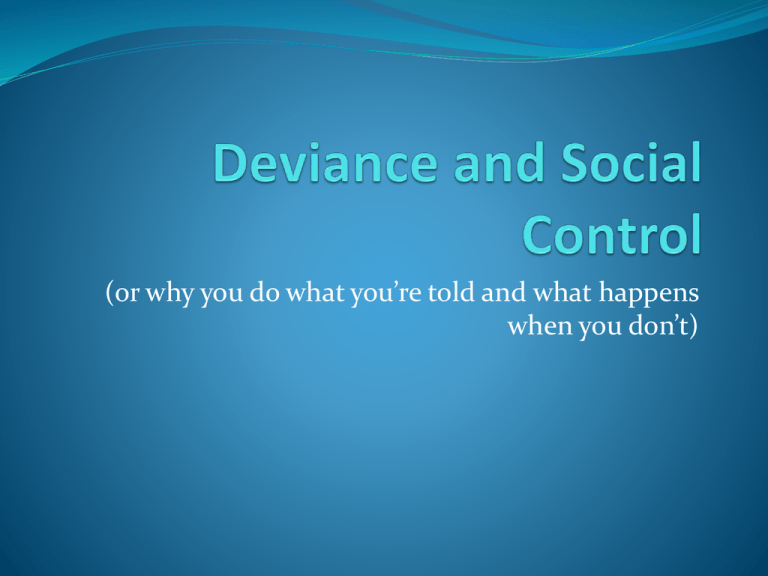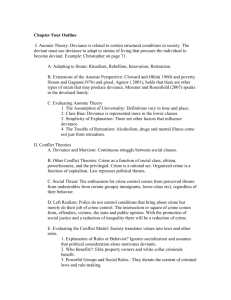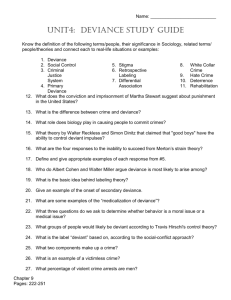
(or why you do what you’re told and what happens
when you don’t)
Deviance and Social Control
Social control
What is deviance?
Explaining deviance
Crime
Social Control
Social control: techniques and strategies for preventing
deviant behavior in any society
Obeying parents
Peer groups
Introduce informal norms
Bureaucratic workers have formal rules and regulation
Government legislates and enforces social norms
Laws
Sanctions
What is the ultimate formal sanction?
People often get competing messages about how to behave
What would the functionalists say about social control?
Social Control
Conformity: going along with peers who have no
special right to direct behavior
Obedience: compliance with higher authorities in an
hierarchical structure
Informal social control: used casually to enforce
norms
Formal social control: carried out by authorized
agents
What are some examples of agents of formal social
control?
Law and Society
Some norms are so important to a society that they
are formalized into laws
Law: governmental social control
Legal order reflects values of those in position to exercise
authority
Socialization is the primary source of conforming and
obedient behavior, including obedience to law
What is deviance?
Deviance: behavior that violates the standards of
conduct or expectations of a group or society
Involves violation of group norms, which may or may not
be formalized into law
Stigma: labels society uses to devalue members of
certain social groups
What sorts of groups do we tend to stigmatize?
Functionalist Perspective
From Durkheim
Punishments established within a culture help define acceptable behavior
and contribute to stability
If improper acts not sanctioned, people might stretch standards of
appropriate conduct
Anomie: loss of direction felt in society when social control of individual
behavior has become ineffective
Anomie Theory of Deviance (Merton): how people adapt in certain
ways by conforming to or by deviating from cultural expectations
Conformist
Innovator
Ritualist
Retreatist
Rebel
Interactionist Perspective
Cultural transmission: one learns how to behave in
social situations, whether properly or improperly
Differential association (Sutherland): process
through which exposure to attitudes favorable to
criminal acts leads to the violation of rules
Social disorganization theory: attributes increases
in crime and deviance to the absence or breakdown
of communal relationships and social institutions
Some critics call this theory “blaming the victim”
Interactionalist Perspective
Labeling theory: attempts to explain why certain people
are viewed as deviants while others are not; also known
as social reaction approach
Some individuals or groups have the power to define labels and
apply them to others
Labeling and Sexual Deviance: Definition of deviant
sexual behavior varied significantly over time and from
culture to culture
• Use of terms, even in positive way, still implies human
sexuality can be confined in neat, exclusive categories
• Definition of sexual deviance seems to change with
each generation
Conflict Theory
People with power protect their own interests and
define deviance to suit their needs
Criminal law reflects competing values and interests
People with power also use sanctions to protect their
own interests
Crack vs. cocaine
Feminist Perspective
Adler and Chesney-Lind suggest that many
approaches to deviance and crime were developed
with men in mind
Society tends to treat women in stereotypical fashion
Cultural views about feminity influence how women are
perceived and labeled
Crime
Crime: violation of criminal law for which some
governmental authority applies formal penalties
Key ingredients in incidence of street crime appear to be
drug use and widespread firearms
Victimless crime: willing exchange among adults of
widely desired, but illegal, goods and services
Professional crime: person who pursues crime as
day-to-day occupation
Types of Crime
Organized crime: Work of a group that regulates
relations between various criminal enterprises
involved in various illegal activities
White-collar and technology-based crime: illegal
acts committed in the course of business activities
Transnational crime: Crime that occurs across
multiple national borders
Crime Statistics
Crime statistics are not as accurate as social scientist
would like, but relate to issue of grave concern to people
Even with current declines, reported crimes in the US are
well above those of other nations
Explanations of decline in violent crime nationwide:
Community-oriented policing and crime prevention programs
New gun control laws
Massive increase in the prison population preventing inmates from
committing crimes outside the prison
There are trends of increasing violent crime in other Western
societies







